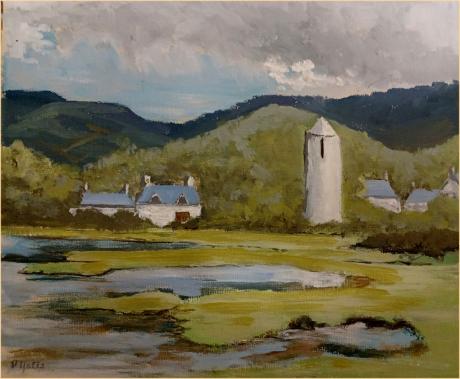" P Yates" and inscribed on the reverse"
The village of Dervaig, pronounced ‘dervig’ goes right back to Viking times, and indeed the name Dervaig means ‘good inlet’ in old Norse. The settlement itself really only goes back to about the time of the first church to be recorded here in the twelve hundreds.
The village can be reached from four directions, Calgary, Tobermory, Salen (‘the Glen Road’) and Torloisk (‘the hill road’). All routes are single track and charmingly twisty. The roads are a favourite choice for our Mull car rally held every October. The main part of the village that you see today was planned and established by Alexander MacLean of Coll in 1799. This plan incorporates the 26 houses that you see down the main street.
Dervaig lies at the head of Loch a'Chumhainn, at the north end of Mull. Its location is 6 miles west of Tobermory on the narrow and exceptionally twisty B8073 which makes its way across the north of the island: but if you're on Mull, you are probably used to driving single track roads. If not, you can visit our feature page on the subject.
Settlement in the area dates back at least as far as the 1200s when a church was established on the rising ground to the east of today's village. And the name itself, coming from the Old Norse for "good inlet" strongly suggests that the Vikings had a foothold here, centuries earlier.
Even earlier signs of settlement come from a number of standing stones on high ground above Dervaig, and in the traces of an ancient fort on top of a rocky knoll just over a mile south-east of the village close to the minor road to Salen. More obvious and more recent are the remains of an old clearance village, standing in the shelter of this rocky knoll: another indication of a very different pattern of settlement in the past.
The village of Dervaig as you see it today dates back to 1799, when Alexander MacLean, the Laird of Coll, established a planned village here. This comprised 26 houses and cottages lining both sides of a single street, each with its own garden and with common grazing provided for residents' livestock. By the late 1800s the village could boast two inns, along with a bakery, a shop, a post office and a smithy.
A stone plaque over the door of what is now the post office in the main street reveals this to have been built as Dervaig's Reading Room in 1898. It went on to serve as the village hall for over a century until the recent arrival of a much larger village hall standing above the village alongside the road to Tobermory. Today the village boasts two shops, but only one inn, the Bellachroy, which opened alongside the main road here in 1608, thus predating the village it now serves by almost two centuries.

